Essex is a county of contrasts, a landscape where ancient history, bustling towns, quiet villages, and sweeping coastlines converge. Lying to the northeast of London, it has long been shaped by its proximity to the capital, yet retains a character distinctly its own. Essex offers everything from Roman ruins to medieval churches, Tudor halls, and the longest pleasure pier in the world. Its variety makes it one of England’s most fascinating counties to explore.
The county’s roots stretch back to antiquity, with Colchester, Britain’s first recorded city, standing as a testament to its Roman past. Across Essex, Norman castles, medieval market towns, and timber-framed villages reflect centuries of prosperity built on wool, trade, and agriculture. Stately homes such as Audley End embody the grandeur of the aristocracy, while small villages like Finchingfield and Thaxted show the enduring charm of rural England.
Essex also boasts one of England’s longest coastlines, a rich tapestry of estuaries, saltmarshes, and seaside resorts. From the oysters of Mersea Island to the sailing traditions of Burnham-on-Crouch and the fun-filled beaches of Southend-on-Sea, the county’s maritime character runs deep. Nature thrives here too, with vast skies over the saltmarshes of Tollesbury and ancient woodland in Epping Forest offering tranquillity away from towns.
Modern Essex is a place of growth and diversity, with towns like Chelmsford and Southend balancing heritage with innovation. Its rail and road links to London make it both commuter territory and a cultural destination in its own right. What makes Essex truly special is its variety: it offers a slice of nearly every facet of English life, from history and heritage to coast and countryside, from thriving cities to remote villages.
Colchester
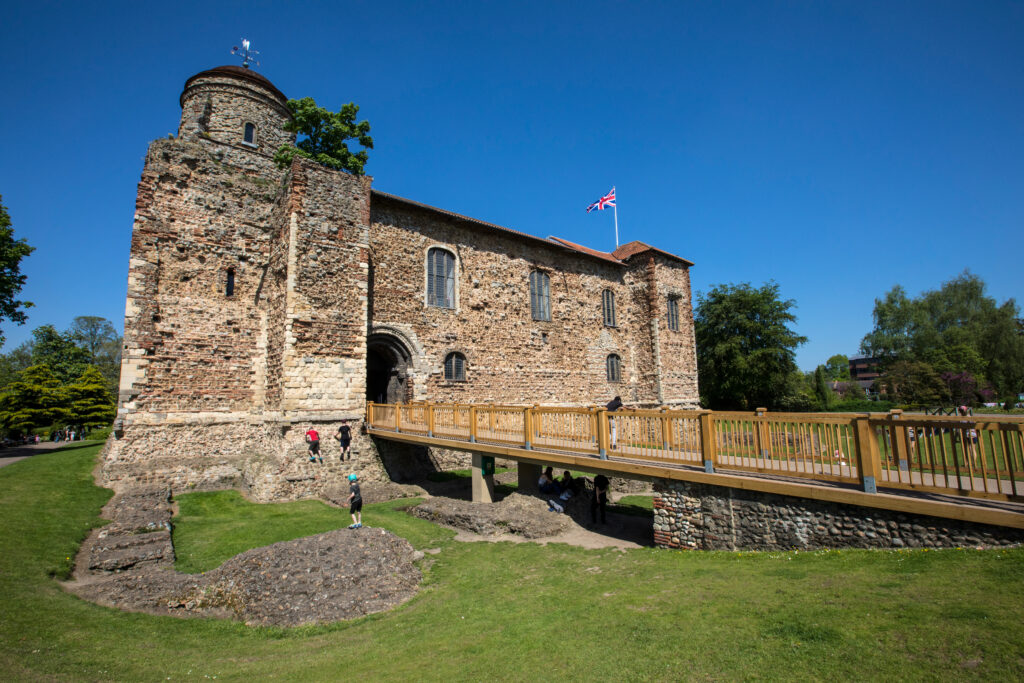
Known as Britain’s first city, Colchester is steeped in history stretching back over 2,000 years. Once the Roman capital of Britain, it still bears the marks of its ancient past. The most striking relic is Colchester Castle, built in the 11th century on the foundations of the Roman Temple of Claudius. Today, the castle houses an excellent museum showcasing the town’s Roman and medieval heritage.
Fragments of the Roman wall still encircle the town, reminding visitors of Colchester’s importance as a strategic centre. Other highlights include the Balkerne Gate, the largest surviving Roman gateway in Britain, and the nearby Roman Circus Centre, where Britain’s only known chariot-racing track once stood.
Beyond its Roman heritage, Colchester has much to offer. The Dutch Quarter, with its narrow lanes and timber-framed houses, reflects the arrival of Flemish weavers in the 16th century. The Victorian Town Hall and Castle Park add further character, while Firstsite, a striking contemporary art gallery, shows how Colchester balances its ancient past with modern creativity.
Colchester’s status as Britain’s first city and its wealth of attractions make it one of the most important places not just in Essex, but in the whole of England.
Chelmsford
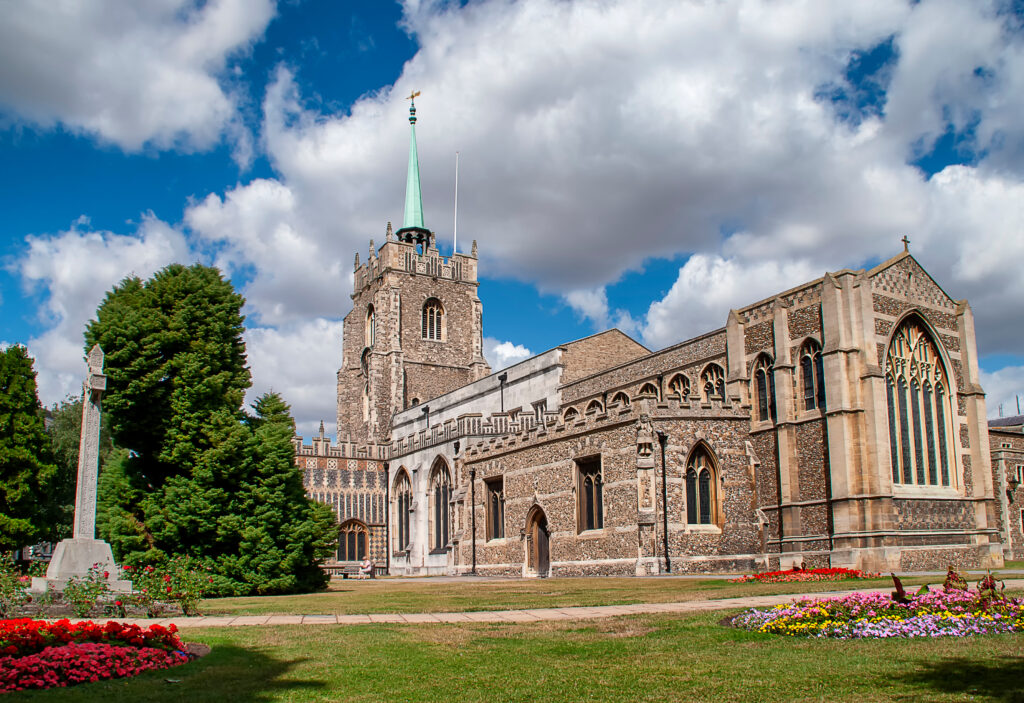
As the county town of Essex, Chelmsford combines historic charm with a modern, dynamic spirit. Its most prominent landmark is Chelmsford Cathedral, one of England’s smallest but most elegant cathedrals, with a light-filled interior and an impressive spire.
Chelmsford has always played a central role in Essex life. Granted city status in 2012, it serves as a commercial, cultural, and administrative hub. In the 20th century, it earned global recognition as the birthplace of radio, thanks to the pioneering work of Marconi, whose first factory was based here. The city honours this legacy with plaques, exhibits, and events that celebrate its technological innovation.
Alongside its heritage, Chelmsford offers vibrant shopping areas, lively nightlife, and expansive green spaces such as Hylands Park, a historic estate that hosts concerts and festivals. The city also sits amid attractive countryside, with riverside walks along the Chelmer and Blackwater Navigation providing peaceful escapes.
Chelmsford represents the modern face of Essex: proud of its history yet firmly looking forward, combining culture, commerce, and community in equal measure.
Saffron Walden

Saffron Walden is one of the most beautiful towns in Essex, a place where medieval charm and Georgian elegance meet. Its name recalls its history as a centre for saffron cultivation, a crop that brought wealth to the town in the Middle Ages.
At the heart of Saffron Walden lies its market square, dominated by the striking Church of St Mary the Virgin, the largest parish church in Essex. Around the square stand timber-framed houses, the medieval guildhall, and colourful Georgian buildings, creating a harmonious townscape.
The town is also famous for its Castle Ruins and Bridge End Garden, a carefully restored Victorian garden with a hedge maze that delights visitors. Just outside Saffron Walden lies Audley End House, one of the grandest Jacobean mansions in England, adding further weight to the town’s historic importance.
Today, Saffron Walden thrives as a cultural and community hub, with markets, fairs, and festivals that continue its traditions. With its heritage, beauty, and welcoming character, it is one of the finest towns not only in Essex but in all of East Anglia.
Audley End House

Just outside Saffron Walden lies Audley End House, one of England’s most magnificent Jacobean mansions. Built in the early 17th century, it was originally intended to be a palace fit for a king, and although later reduced in size, it remains breathtaking in scale and splendour.
The house itself is a masterpiece of architecture, with richly decorated interiors that include a great hall, state apartments, and intimate family rooms. Visitors can also explore the Victorian service wing, where kitchens, laundries, and stables reveal the daily life of those who worked behind the scenes.
Audley End is equally renowned for its gardens, designed in part by Capability Brown. Sweeping lawns, a serpentine lake, and carefully planted woodlands frame the house, while the formal parterre and Victorian kitchen garden provide colour and produce. The estate is also home to a reconstructed 17th-century garden and an array of rare plants and trees.
Today managed by English Heritage, Audley End House offers a glimpse into aristocratic life on a grand scale, making it one of the most important historic houses in England.
Thaxted
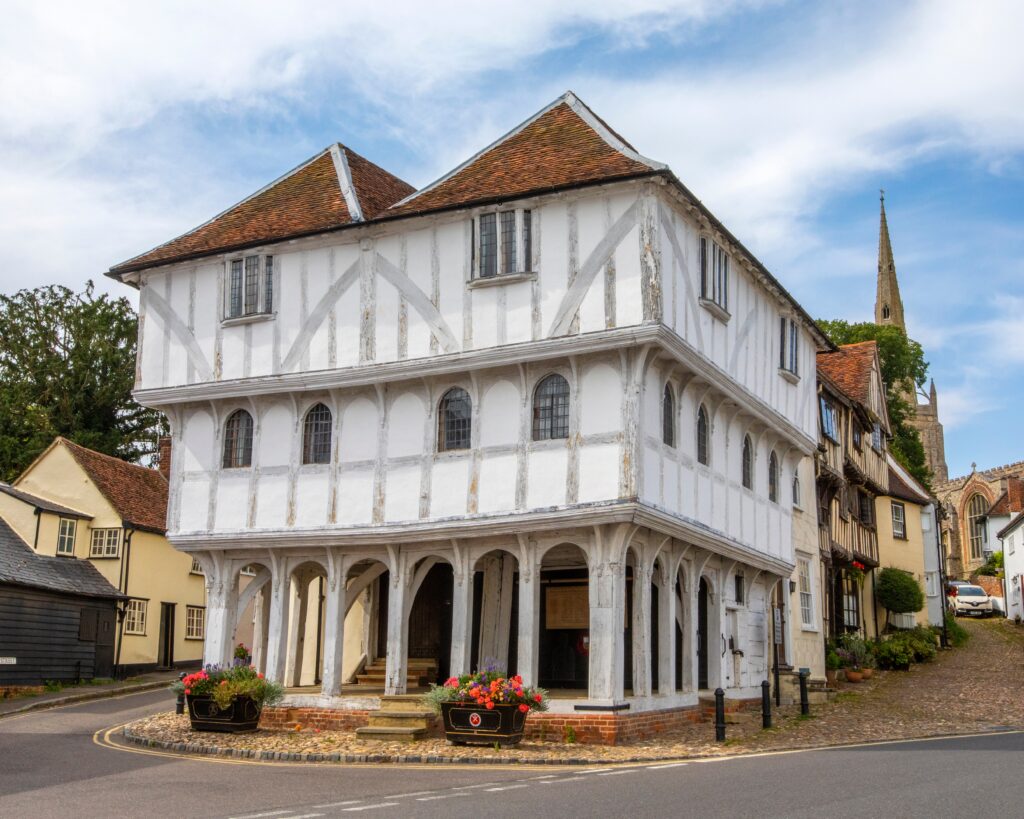
Thaxted is one of Essex’s most picturesque towns, known for its medieval guildhall, impressive church, and traditional music and festivals. Once a centre of the cutlery trade, the town prospered in the Middle Ages, leaving behind a rich architectural legacy.
The most striking landmark is the Guildhall, built in the 15th century, with its timber-framed upper storey and open ground floor where markets once bustled. Nearby stands the Church of St John the Baptist, St Mary and St Laurence, often described as the “Cathedral of Essex” due to its grandeur and scale. Its tall spire dominates the skyline, a symbol of the town’s prosperity.
Thaxted is also home to a restored windmill, another feature that adds to its charm. The town’s cultural life remains vibrant, with annual events such as the Thaxted Music Festival and the traditional Morris dancing gatherings, which celebrate English folk culture.
With its medieval heritage, lively traditions, and artistic spirit, Thaxted offers a captivating blend of history and living culture.
Dedham

Set on the River Stour, Dedham lies at the heart of Constable Country, the landscape immortalised by the painter John Constable. The town itself is full of Georgian houses, timber-framed buildings, and a sense of timeless rural charm.
The most prominent landmark is the Church of St Mary the Virgin, whose tower was a favourite subject of Constable’s paintings. The riverbanks around Dedham provide some of the most iconic views in English art, particularly when walking the Dedham Vale, a designated Area of Outstanding Natural Beauty.
Dedham also has a strong cultural legacy, with galleries and exhibitions celebrating Constable’s work and the continuing inspiration of the landscape. Its High Street, lined with shops, tearooms, and pubs, makes it a lively centre within a tranquil countryside setting.
Dedham perfectly combines heritage, art, and natural beauty, offering a chance to step into the very landscapes that shaped one of England’s greatest painters.
Manningtree

Often called England’s smallest town, Manningtree may be small in size but it is rich in history and character. Situated on the banks of the River Stour, it is closely linked to Constable Country, with landscapes around the town inspiring the works of John Constable.
Manningtree flourished as a port town during the medieval and early modern periods, with trade along the Stour shaping its growth. Its quayside retains a strong maritime atmosphere, lined with old warehouses and historic buildings. The compact High Street is full of charm, with Georgian houses, traditional pubs, and small independent shops.
The town also has a darker historical association as the base of Matthew Hopkins, the infamous “Witchfinder General” of the 17th century, who carried out witch trials in the area. Despite this grim past, Manningtree today is a lively community with a friendly atmosphere, especially during local festivals and riverside events.
Its location on the Stour makes it ideal for walking and boating, with excellent connections to nearby Dedham and Flatford. For those seeking beauty, history, and tranquillity all in one, Manningtree is a hidden gem of Essex.
Harwich
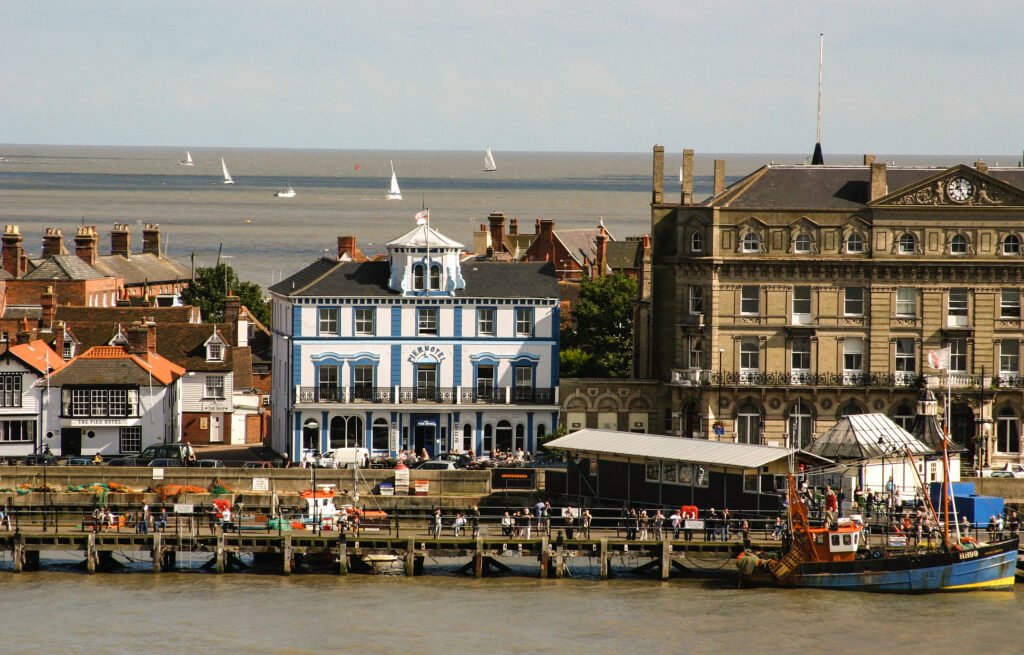
Harwich is one of England’s most historic ports, its maritime legacy stretching back centuries. Located at the confluence of the Stour and Orwell estuaries, it has been a naval stronghold, trading hub, and shipbuilding centre. The town is still home to a major port, but its old town preserves a wealth of heritage.
The narrow streets of Harwich are lined with Georgian houses, historic inns, and landmarks such as the Guildhall and Redoubt Fort, an impressive 19th-century defensive structure. Harwich also played a key role in naval history: the Royal Navy Dockyard, dating to the 17th century, was where many important ships were built.
One of Harwich’s most intriguing attractions is the Electric Palace Cinema, one of the oldest purpose-built cinemas in Britain, dating from 1911. Visitors can also explore the Ha’penny Pier, a Victorian structure that offers excellent views across the harbour.
Harwich’s blend of maritime heritage, historic architecture, and working port makes it one of Essex’s most fascinating and distinctive towns.
Mersea Island
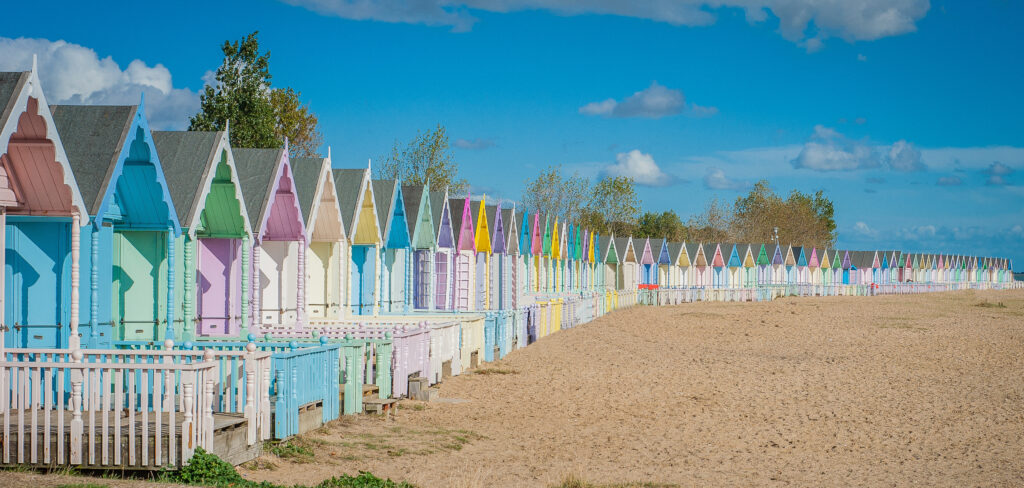
Mersea Island, connected to the mainland by a causeway that floods at high tide, is a unique and atmospheric destination. Known for its seafood, especially the famous Mersea oysters, the island has been a centre of fishing for centuries. Oysters from Mersea were prized by the Romans, and the tradition continues today with oyster sheds and seafood restaurants lining the waterfront.
The island is divided into West Mersea and East Mersea, each with its own character. West Mersea is the main settlement, with colourful beach huts, sailing clubs, and seafood eateries. East Mersea is quieter, home to the Cudmore Grove Country Park, where saltmarshes, beaches, and grazing meadows provide a haven for wildlife and walkers.
Mersea Island also has a strong maritime tradition, with sailing regattas and festivals celebrating its coastal identity. Its tidal nature adds to its charm, offering a sense of remoteness despite being so close to Colchester.
For those seeking a blend of history, nature, and food, Mersea Island is one of the true treasures of the Essex coast.
Maldon

Maldon, set on the banks of the River Blackwater, is one of Essex’s most characterful towns, renowned for its maritime heritage, salt-making, and historic charm. Its history stretches back to Saxon times, most famously commemorated in the epic Battle of Maldon (991 AD), where local forces fought against Viking invaders.
The town’s quayside is one of its most iconic features. Here, historic Thames sailing barges line the river, symbols of Maldon’s long tradition of estuarine trade. The quay is also the centre of the town’s vibrant events calendar, from regattas to food festivals. Maldon is equally famous for Maldon Sea Salt, a product with international acclaim, harvested using centuries-old techniques.
The High Street is full of character, with independent shops, tea rooms, and pubs housed in historic buildings. Nearby Promenade Park, created in the 19th century, offers expansive green spaces, ornamental gardens, and riverside walks that make it popular with families.
With its mix of history, salt marsh landscapes, and strong maritime traditions, Maldon captures the very essence of coastal Essex.
Heybridge Basin
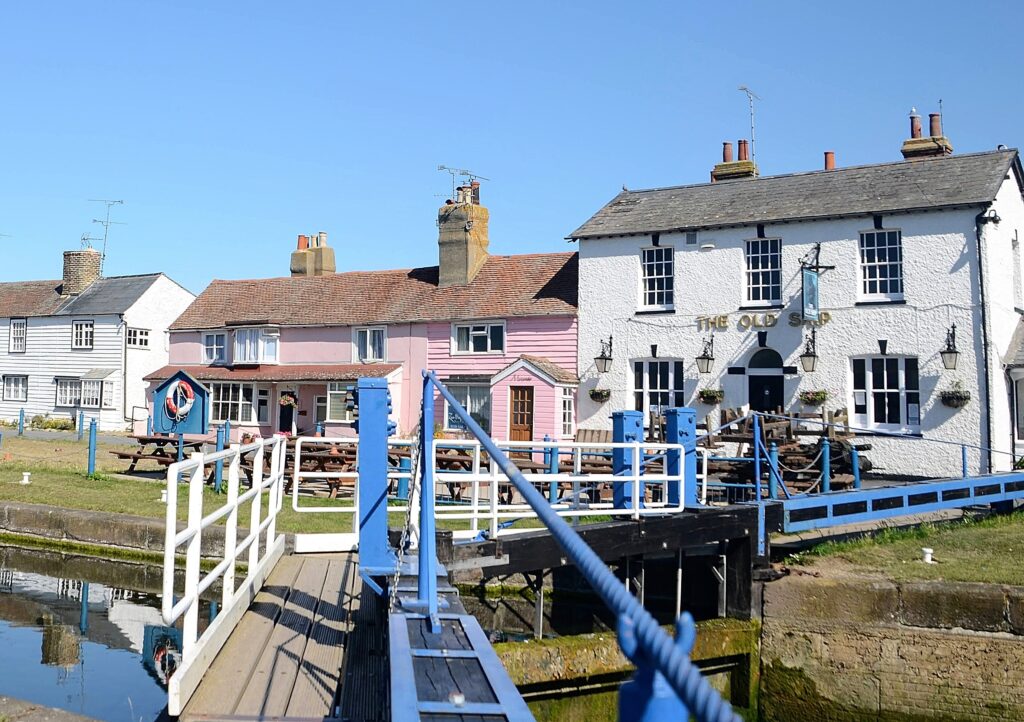
Just a short distance from Maldon lies Heybridge Basin, a small but enchanting waterside village. Situated where the Chelmer and Blackwater Navigation meets the Blackwater Estuary, it has long been a favourite spot for sailors, walkers, and those seeking peaceful estuarine views.
The heart of the village is its lock and basin, where pleasure boats and barges gather. Two traditional pubs, including the much-loved Old Ship Inn, overlook the water, offering excellent places to enjoy seafood or a pint while watching the tide roll in.
Heybridge Basin also serves as the gateway to stunning walks along the sea wall, which stretches out into the salt marshes and mudflats of the estuary. Birdwatchers flock here to see waders and migratory species that thrive in the tidal habitats.
Although modest in size, Heybridge Basin’s charm lies in its tranquillity, its views, and its sense of being tucked away from the world. For many visitors, it is the perfect spot to experience the slower, gentler rhythms of coastal Essex.
Burnham-on-Crouch
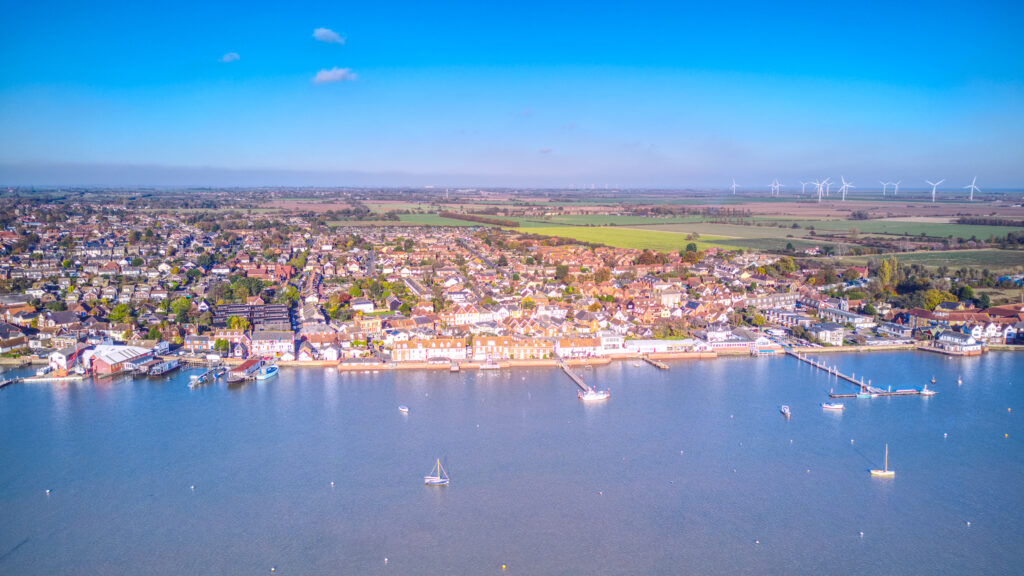
Known as the sailing capital of the East Coast, Burnham-on-Crouch is a picturesque town on the River Crouch with a long maritime tradition. Its riverside setting, colourful regattas, and historic High Street make it one of the gems of coastal Essex.
The town flourished as a fishing port in earlier centuries, but today it is celebrated for sailing. The annual Burnham Week Regatta, dating back to the late 19th century, remains one of the premier sailing events in the country, drawing yachts and sailors from across the UK and beyond.
Burnham’s High Street is lined with Georgian houses, boutique shops, and cosy pubs, many of which reflect the town’s maritime heritage. The quayside offers excellent views of the river, dotted with yachts and traditional boats. Walking trails along the Crouch estuary lead into landscapes of saltmarsh and farmland, rich in wildlife and wide skies.
Burnham-on-Crouch is both a lively sailing hub and a charming riverside town, balancing sporting energy with timeless beauty.
Southend-on-Sea
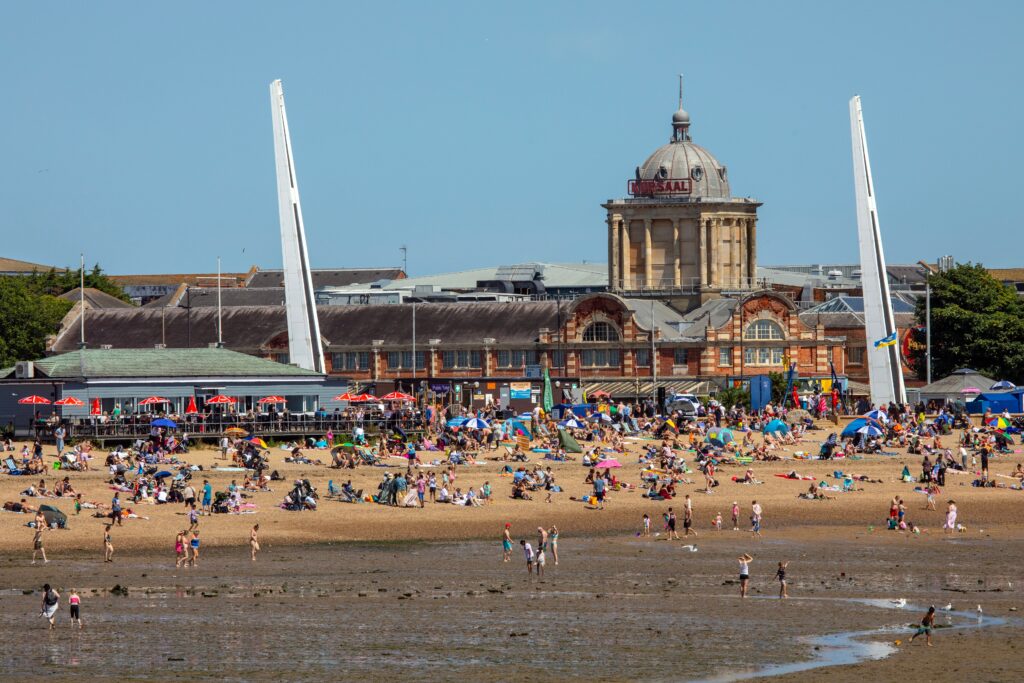
Southend-on-Sea is perhaps Essex’s most famous seaside resort, celebrated for its lively atmosphere and its record-breaking pier – the Southend Pier, at over 1.3 miles, is the longest pleasure pier in the world. A railway takes visitors to the end, offering stunning views over the Thames Estuary.
The town’s reputation as a holiday destination grew during the Victorian era, when improved rail links brought day-trippers from London. Today, Southend continues to thrive as a seaside hub with sandy beaches, arcades, and attractions like Adventure Island, a family-friendly amusement park.
Southend is also home to cultural highlights, including the Focal Point Gallery, which champions contemporary art, and the Clifftown Theatre, bringing drama and music to the seaside setting. Its High Street offers shopping and dining, while the seafront remains the heart of the town, with fish and chips, fairground rides, and a vibrant nightlife.
Southend combines traditional seaside fun with modern attractions, ensuring it remains a beloved destination for both locals and visitors alike.
Leigh-on-Sea
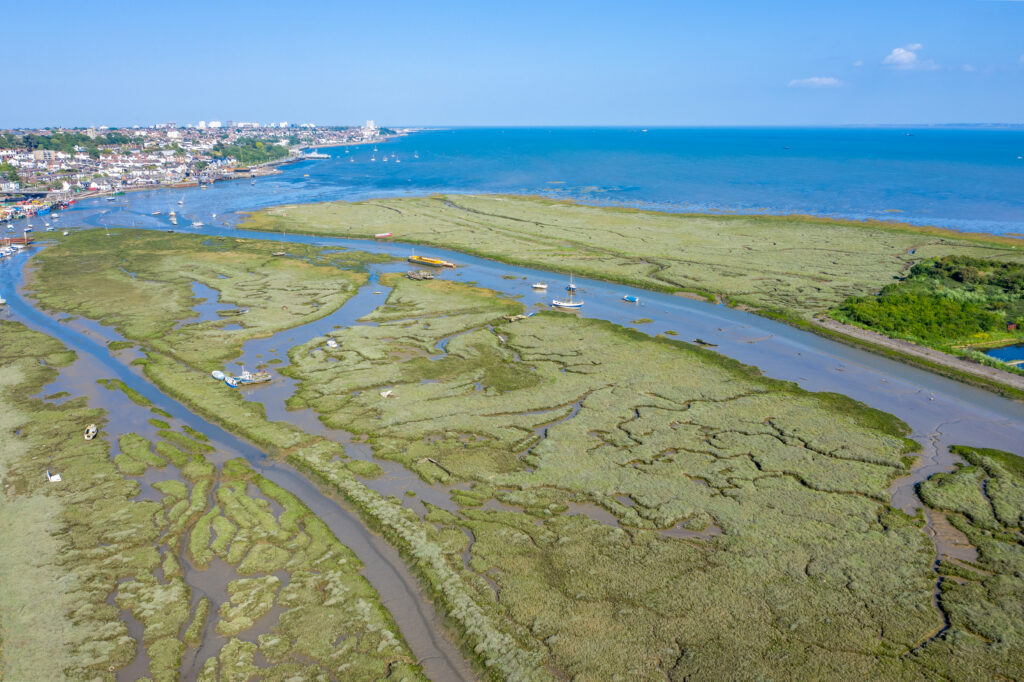
Just west of Southend lies Leigh-on-Sea, a historic fishing village that has evolved into a lively town while retaining its maritime soul. The heart of Leigh is its Old Town, a narrow strip along the estuary where cockle sheds, pubs, and fishing boats cluster together, creating one of the most atmospheric coastal scenes in Essex.
Leigh’s oysters and cockles are legendary, with seafood stalls and pubs offering freshly caught delicacies straight from the boats. The town also celebrates its maritime traditions with festivals and events, including the Leigh Folk Festival, which is one of the largest free folk music events in the UK.
Away from the Old Town, Leigh has a bustling Broadway lined with independent shops, cafés, and galleries, reflecting the town’s growing artistic community. Its views across the Thames Estuary are spectacular, particularly at sunset, when the mudflats and boats are bathed in golden light.
Leigh-on-Sea’s blend of history, seafood, and cultural vibrancy makes it one of Essex’s most distinctive coastal towns.
Epping Forest
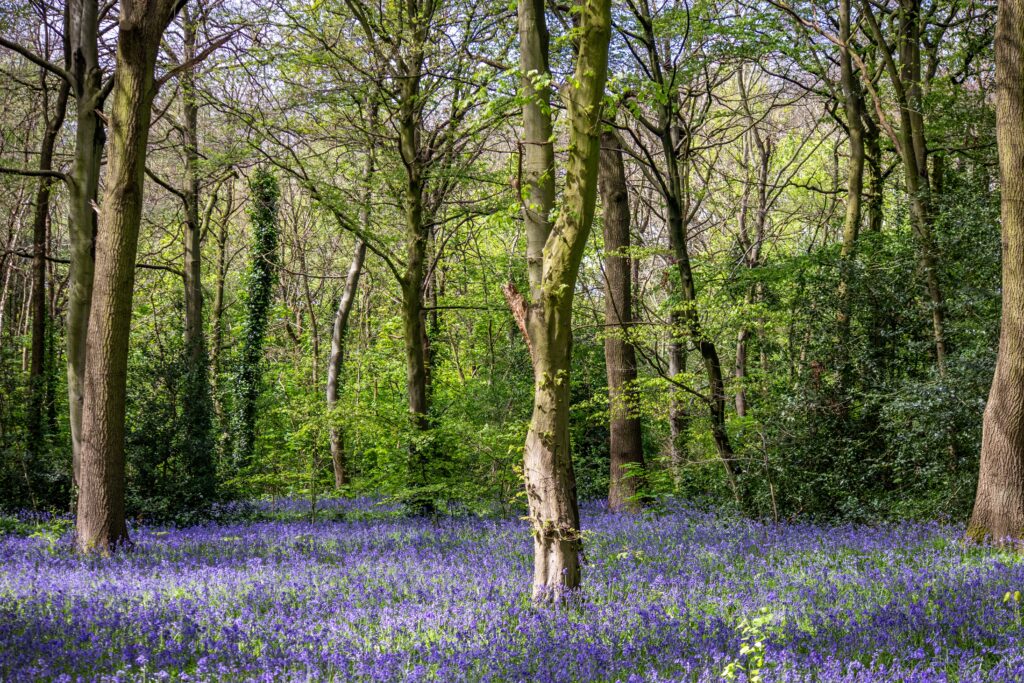
Epping Forest is one of England’s most celebrated ancient woodlands, stretching for 12 miles along the border of Essex and London. Covering over 6,000 acres, it has been a royal hunting ground since the time of the Normans and remains a treasured green lung for the region.
The forest is characterised by its ancient pollarded trees, many of which are hundreds of years old. Oak, beech, and hornbeam dominate the landscape, creating a rich and diverse woodland habitat. It is also home to heathlands, grasslands, and ponds, making it a haven for wildlife from deer to rare insects and birds.
Epping Forest has long inspired writers and artists. It was a favourite haunt of Alfred Lord Tennyson and features in the works of countless painters. Today, it is cherished for walking, cycling, and horse riding, with miles of trails offering peaceful escapes from urban life.
Managed by the City of London Corporation, Epping Forest remains a place where history, nature, and recreation intertwine, making it one of Essex’s most iconic landscapes.
Waltham Abbey
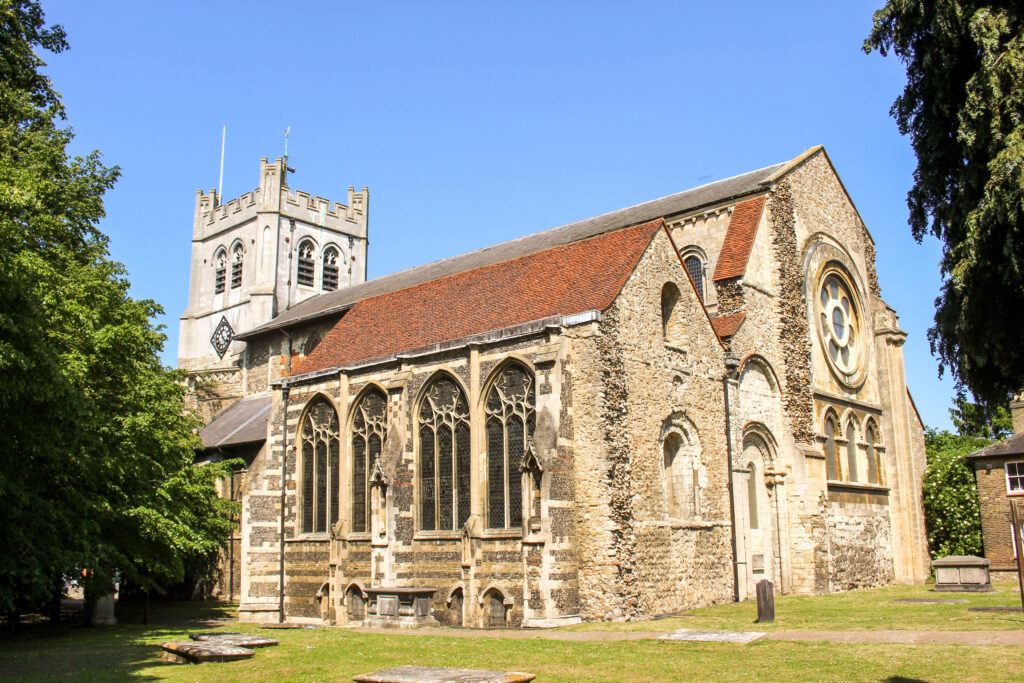
Waltham Abbey, located on the edge of Epping Forest, is a historic market town centred around its magnificent Abbey Church of Waltham Holy Cross. The abbey has deep roots in English history: it was one of the most important religious foundations in the country and is famously associated with King Harold II, the last Anglo-Saxon king of England, who is said to be buried here after the Battle of Hastings in 1066.
Although much of the abbey was dissolved under Henry VIII, the surviving church remains impressive, with its striking Norman architecture and later Gothic additions. The surrounding abbey grounds, with their cloister ruins and gardens, evoke the grandeur of the site’s monastic past.
The town itself has a lively market tradition, with local stalls and shops adding to its charm. Its proximity to both Epping Forest and the River Lea makes it a gateway to countryside walks and waterways.
Waltham Abbey stands as both a place of pilgrimage and a living market town, balancing heritage with community spirit.
Ingatestone
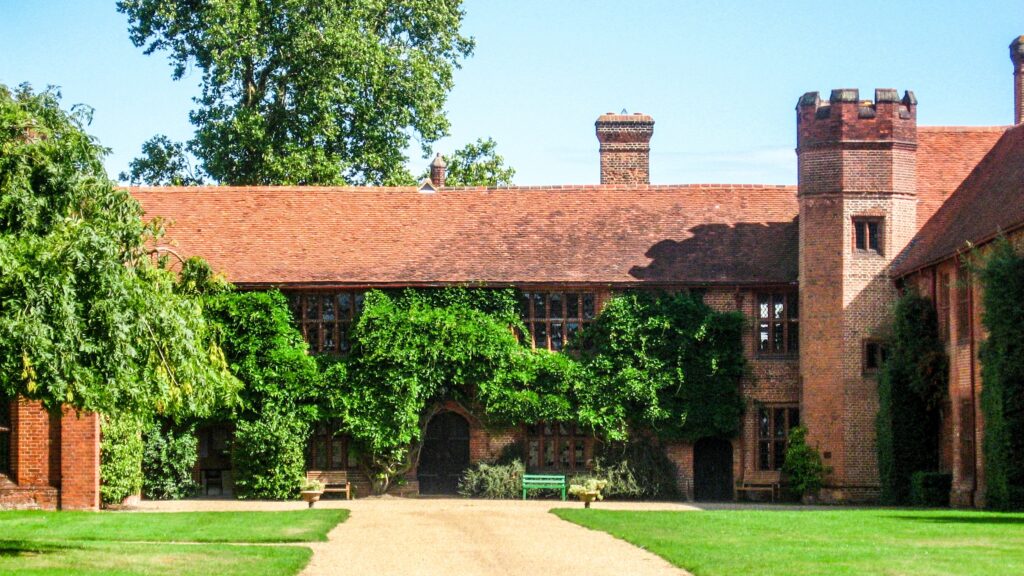
Ingatestone is a historic Essex village best known for Ingatestone Hall, a Tudor mansion built in the 16th century by Sir William Petre, Secretary of State to four Tudor monarchs. Still owned by the Petre family today, the hall offers a remarkable glimpse into Tudor life with its original features, priest holes, and beautiful gardens.
The village itself grew along the old Roman road that became the Great Eastern coaching route, giving Ingatestone a long history as a stopping point for travellers. Its High Street remains charming, lined with Georgian and Victorian houses, independent shops, and cosy pubs.
The surrounding countryside of farmland and woodlands adds to its appeal, offering excellent walks and cycling routes. Ingatestone combines deep Tudor history with the character of a living village, making it both picturesque and historically significant.
Hatfield Peverel

Hatfield Peverel, located between Chelmsford and Witham, is a village with a long and fascinating past. Its most significant historic feature is the remains of the Benedictine Priory of St Mary and St John, founded in the 12th century. The priory was later transformed into the parish church of St Andrew’s, which still contains elements of Norman architecture.
The village grew as a centre of agriculture and trade, aided by its position on the London to Colchester road. Its modern identity is closely tied to its strong community spirit, with village events, fairs, and local traditions playing an important role.
Surrounded by rolling farmland and dotted with historic buildings, Hatfield Peverel offers a blend of medieval heritage and rural charm. Its location makes it a convenient yet peaceful stop for those exploring the heart of Essex.
Finchingfield
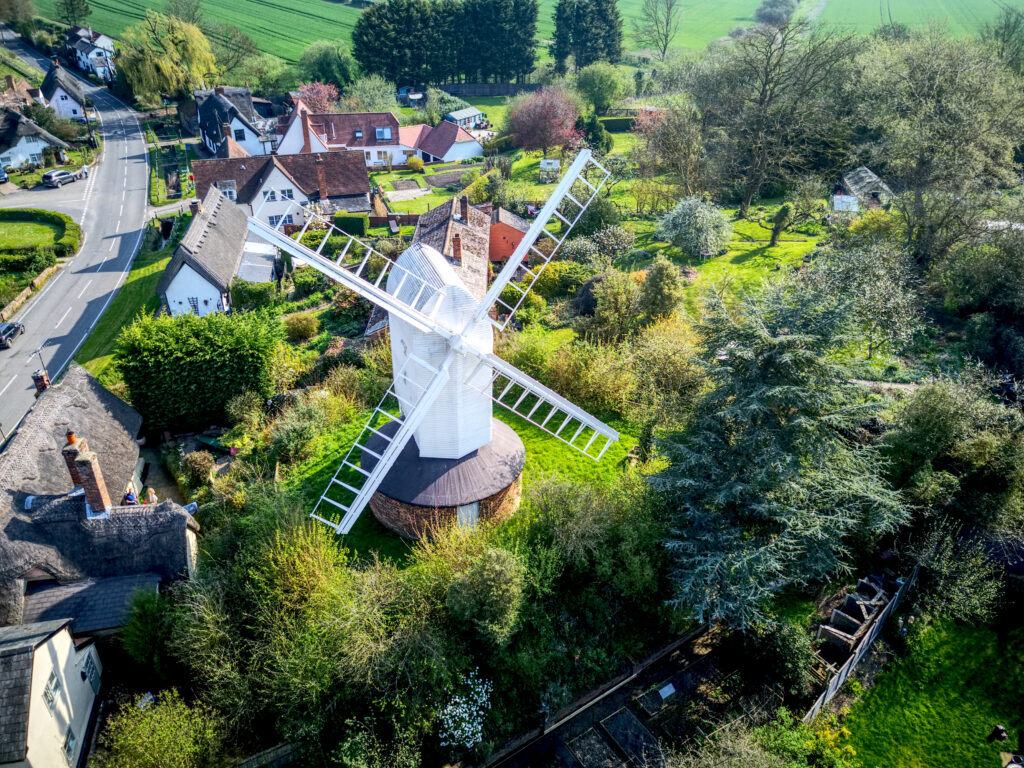
Often described as the most beautiful village in Essex, Finchingfield is a picture-postcard scene of English rural life. Its triangular village green, complete with duck pond, is surrounded by pastel-painted cottages, historic pubs, and the imposing Church of St John the Baptist, which rises on the hill above.
The village owes much of its beauty to its medieval and Georgian heritage, with timber-framed houses and old almshouses creating a timeless atmosphere. A windmill and a series of small bridges across the pond and streams add to the idyllic scene.
Finchingfield has inspired artists and writers for centuries, its harmonious setting often described as the epitome of English village life. Despite attracting many visitors, it has retained its sense of tranquillity and authenticity.
For those seeking the romantic vision of rural England, Finchingfield stands as one of the finest examples anywhere in the country.
Great Dunmow

Great Dunmow is a charming market town in north Essex, best known for its quirky and unique tradition: the Flitch Trials. Dating back to medieval times, this custom awards a flitch of bacon to married couples who can swear, before a jury of bachelors and maidens, that they have lived in harmony for a year and a day. The trials are still held every four years, making Great Dunmow famous for one of England’s most unusual folk customs.
The town itself has a long history, with Roman origins and later prosperity as a market centre. Its High Street is lined with Georgian and timber-framed buildings, creating an attractive streetscape. The Doctor’s Pond, once used to breed fish for the monks of Dunmow Priory, is another notable feature that adds to the town’s charm.
Surrounded by gentle countryside and with a strong sense of tradition, Great Dunmow represents the character and humour of rural Essex at its most distinctive.
Coggeshall
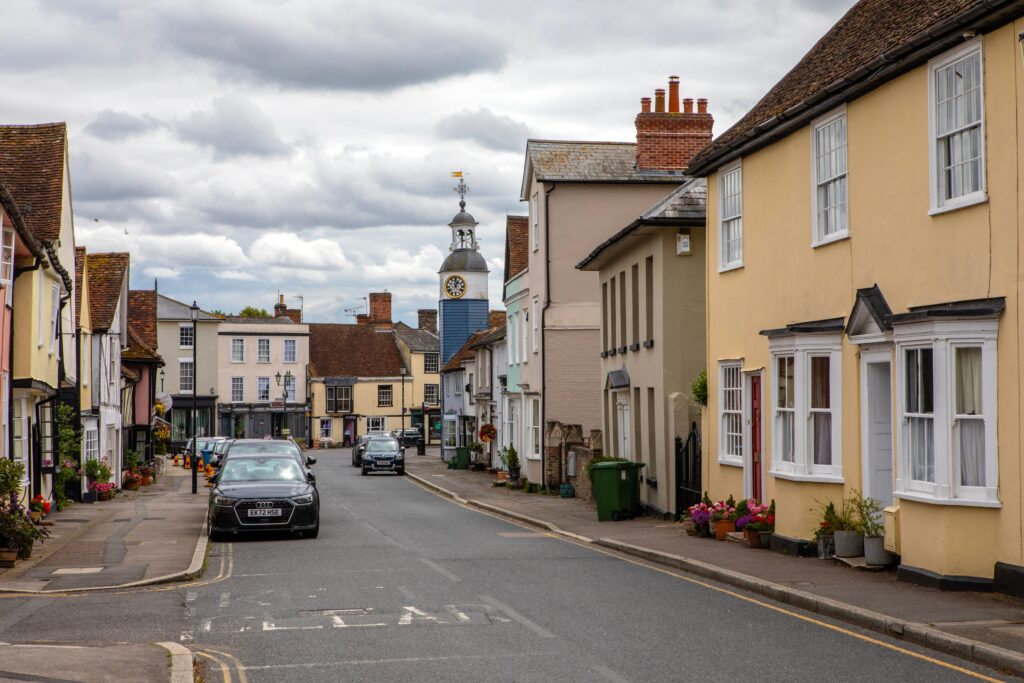
Coggeshall is one of Essex’s most beautiful and historic towns, famous for its half-timbered houses and medieval heritage. Known as the “antique capital of Essex”, it is full of antique shops, independent businesses, and historic buildings that make wandering its streets a delight.
The town has a long association with the wool trade, which brought prosperity in the Middle Ages. This wealth is reflected in landmarks such as St Peter-ad-Vincula Church, one of the grandest “wool churches” in Essex, and the 16th-century Paycocke’s House, a beautifully preserved merchant’s house now managed by the National Trust.
Another highlight is Coggeshall Abbey, founded in the 12th century, with atmospheric remains that showcase its monastic past. The town’s layout and architecture reflect centuries of history, with every corner offering a sense of continuity and charm.
Coggeshall’s blend of heritage, antiques, and community life makes it a quintessentially Essex gem, deeply rooted in both history and tradition.
Braintree

Braintree is a historic market town whose identity was shaped by the wool trade of the Middle Ages and later by its thriving textile industry. By the 19th century, Braintree was a centre for silk production, with companies like Courtaulds leaving a strong industrial legacy. Today, that history is preserved in the Warner Textile Archive, which holds one of Britain’s most important collections of fabrics and designs.
The town centre combines historic charm with modern amenities. The George Yard Shopping Centre offers a contemporary retail space, while the High Street retains older buildings that reflect Braintree’s past. The town is also home to the Braintree District Museum, where visitors can learn about the area’s industrial heritage and notable figures.
Surrounded by gentle Essex countryside, Braintree also serves as a base for outdoor pursuits, with the Flitch Way, a long-distance trail along a former railway line, offering excellent walking and cycling routes.
Braintree is a town that bridges past and present, where industrial history and modern living coexist in harmony.
Witham

Witham is a traditional Essex market town located on the River Brain. Its history stretches back to Saxon times, but it developed significantly in the medieval period as an agricultural and trading centre. The parish church of St Nicolas, with its tall spire, is one of the town’s most prominent landmarks.
Witham became particularly important during the 18th century, when the town was transformed by the Witham Spa, attracting visitors for its medicinal waters. Later, Witham’s position on the Great Eastern Railway line between London and Norwich encouraged growth as a commuter town, a role it continues today.
Despite its modern development, Witham retains a strong sense of history and community. The High Street features a mix of Georgian and Victorian architecture, while green spaces such as Whetmead Nature Reserve provide a natural retreat.
With its heritage, accessibility, and welcoming character, Witham captures the balance of old and new that defines many Essex towns.
Wivenhoe

Wivenhoe is one of the most enchanting riverside towns in Essex, located on the banks of the River Colne near Colchester. Once a busy port and shipbuilding centre, Wivenhoe has evolved into a haven for artists, writers, and students, thanks in part to its proximity to the University of Essex.
The town’s historic quayside remains its heart, lined with old warehouses, cottages, and pubs that reflect its maritime heritage. The waterfront is a perfect place for walking, with boats moored along the river and views across the estuary.
Wivenhoe’s charm lies in its artistic and bohemian spirit. The town is known for its galleries, studios, and festivals, with a community that celebrates creativity. Narrow streets lined with pastel-painted cottages add to its appeal, while its pubs and cafés create a warm and lively atmosphere.
For those seeking a blend of history, riverside tranquillity, and artistic energy, Wivenhoe is one of the most delightful destinations in Essex.
Tollesbury
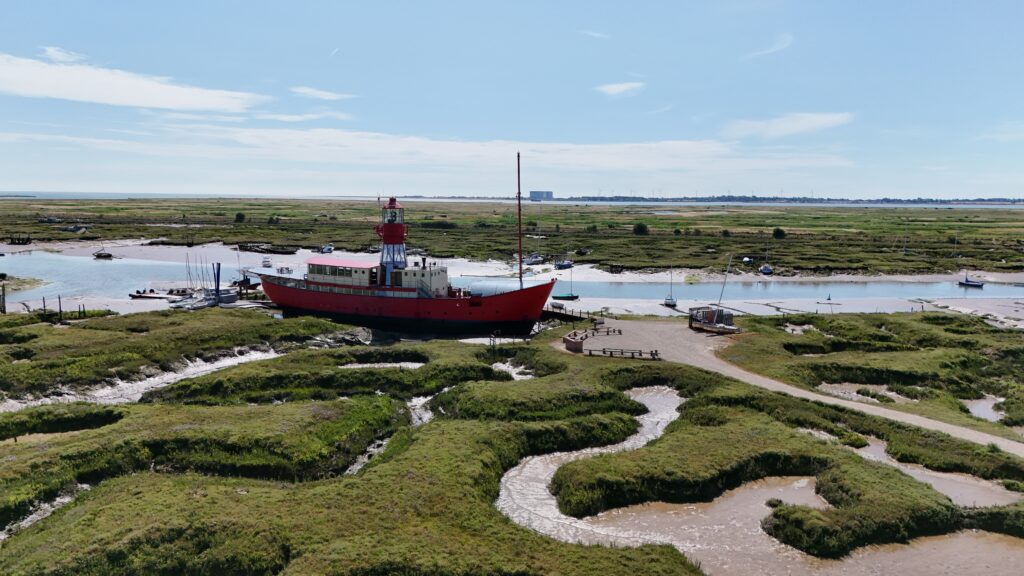
Tollesbury is a quintessential Essex sailing village, set on the Blackwater Estuary and surrounded by vast saltmarshes and creeks. Known as the “village of the plough and sail,” Tollesbury has a dual heritage: agriculture and seafaring. For centuries, villagers worked both the land and the sea, a tradition still visible in the landscape.
At its heart lies the Tollesbury Marina, where yachts and traditional fishing boats share the waters. The surrounding saltmarshes are a haven for wildlife, with rich birdlife making the area popular among birdwatchers and walkers. The extensive sea walls provide some of the best coastal walks in Essex, offering sweeping views across the estuary.
Tollesbury is also famous for its oyster beds, which date back to Roman times and continue to produce some of the finest oysters in England. Its maritime character is celebrated in the annual regattas and local sailing clubs.
With its unspoiled coastal scenery, sailing traditions, and strong community identity, Tollesbury represents the very best of maritime Essex.
Brightlingsea
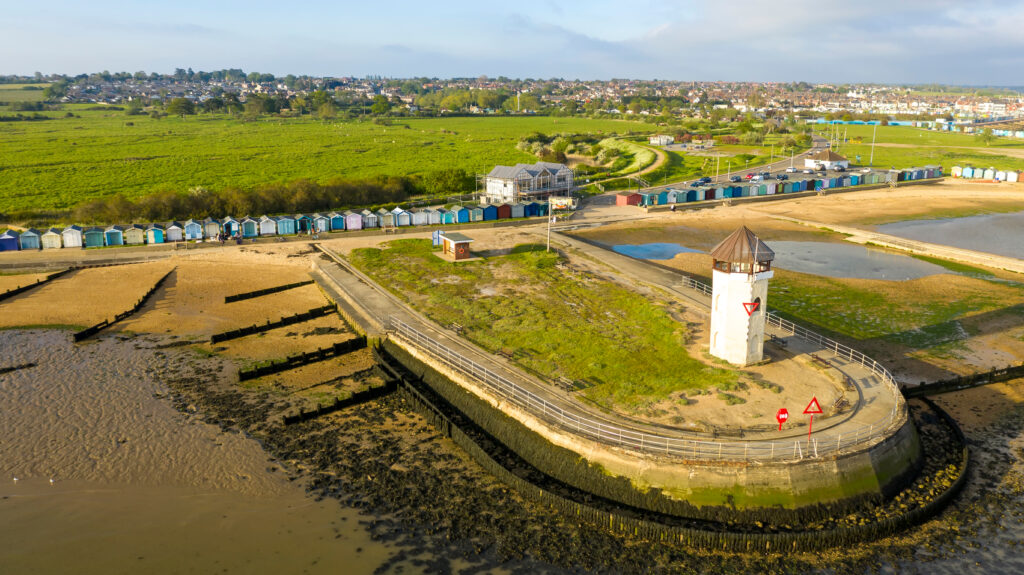
Brightlingsea is a vibrant coastal town on the River Colne estuary, with a proud maritime heritage and a close-knit community spirit. Once a Cinque Port limb, Brightlingsea was heavily involved in shipping, shipbuilding, and fishing. Today, its waterfront still reflects this legacy, with colourful beach huts, working boats, and sailing clubs lining the shore.
The town’s harbour is central to its life, with both commercial and leisure craft filling the estuary. Bateman’s Tower, an octagonal folly at the waterfront, serves as one of its most recognisable landmarks. Brightlingsea’s beaches, though small, are popular with families, while the promenade and lido offer traditional seaside fun.
The town also has a strong tradition of oystering, and its links to the sea are celebrated through festivals and maritime events. The surrounding saltmarshes and nature reserves make it a wonderful spot for wildlife watching and coastal walks.
Brightlingsea captures the essence of a traditional English coastal town, with a proud seafaring past and a lively present.
Canvey Island
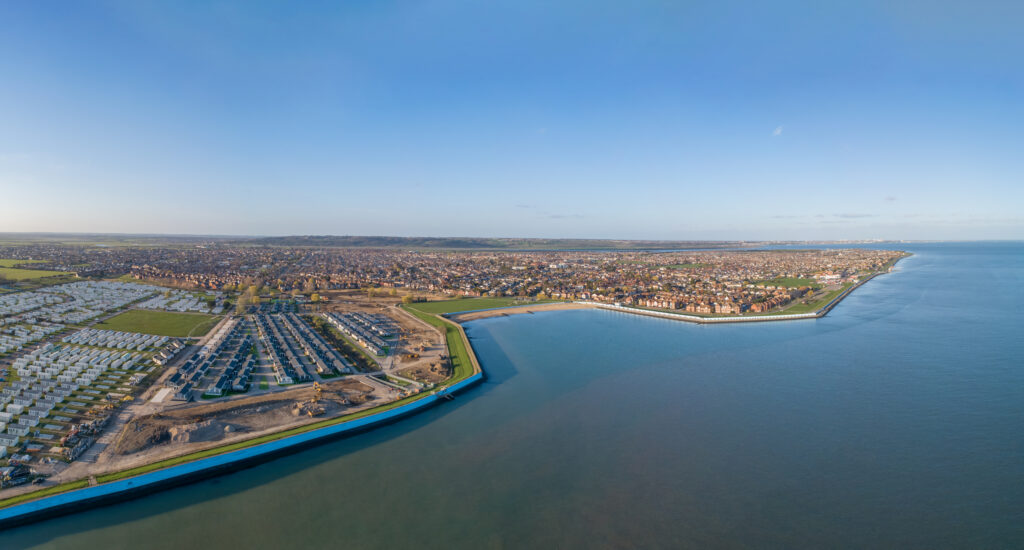
Canvey Island, set in the Thames Estuary, is one of Essex’s most distinctive coastal communities. Reclaimed from the sea in the 17th century by Dutch engineers, the island has long battled against the tides, with sea walls protecting its low-lying land. This unique history gives Canvey a character unlike anywhere else in Essex.
In the 20th century, Canvey grew into a popular seaside resort, attracting visitors with its beaches, amusements, and holiday atmosphere. The island still retains that sense of seaside fun, with attractions such as Canvey Island Seafront, Leisure Island Fun Park, and stretches of sandy beach.
Beyond its resort identity, Canvey has a fascinating heritage. The Dutch Cottage Museum, housed in one of the original round houses built by Dutch settlers, tells the story of the island’s reclamation. Nature also thrives here, with the RSPB West Canvey Marshes offering birdwatching opportunities across its wetlands.
Canvey Island combines seaside entertainment, unique history, and natural beauty, making it a fitting conclusion to the diverse and colourful landscapes of Essex.

